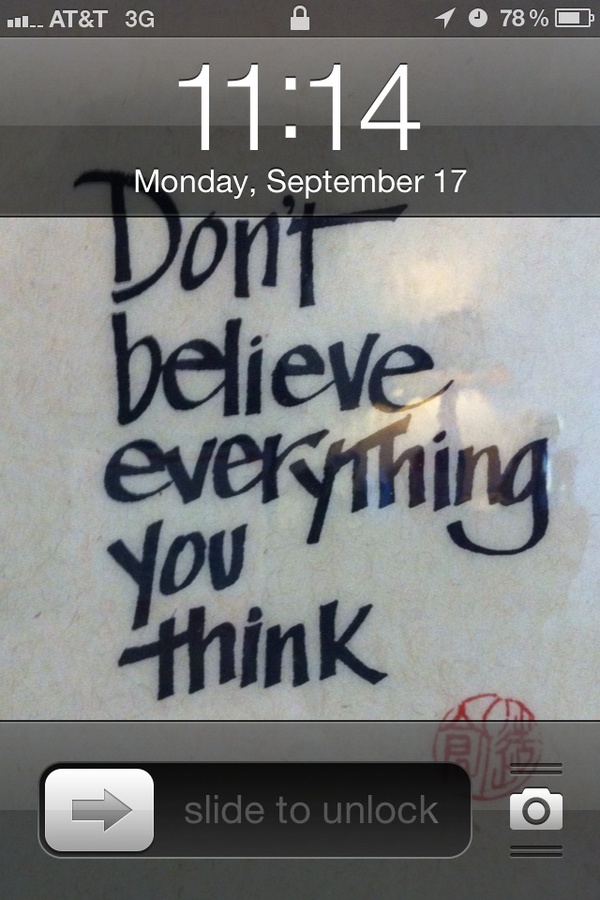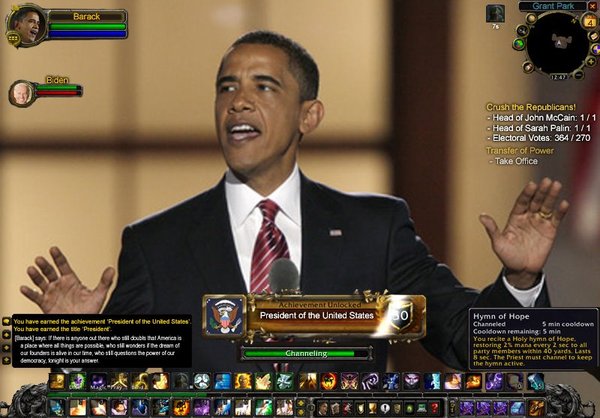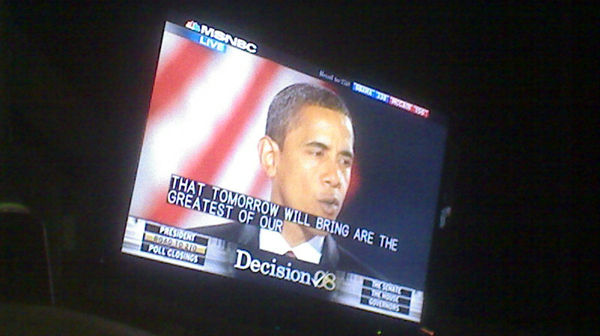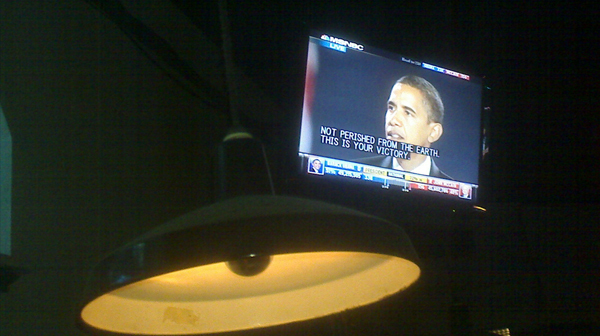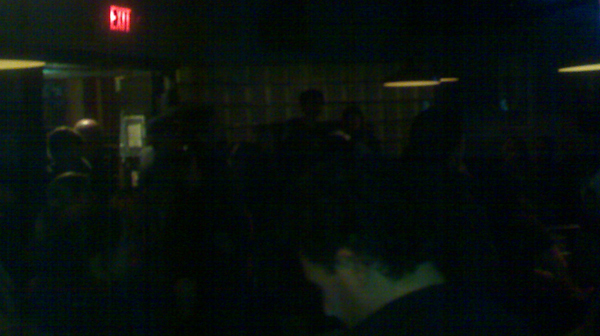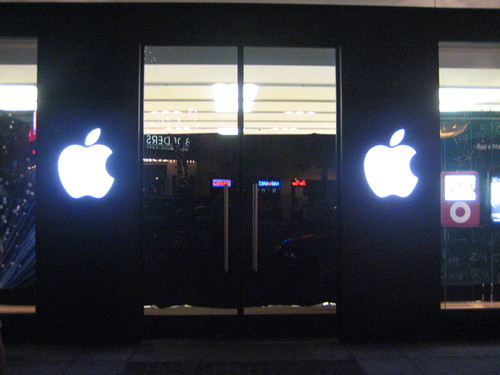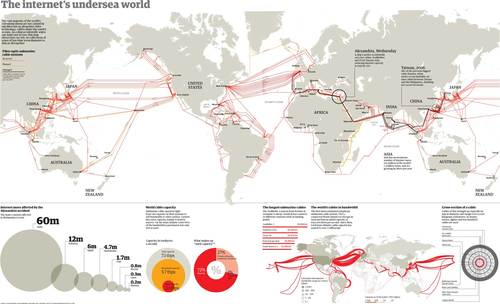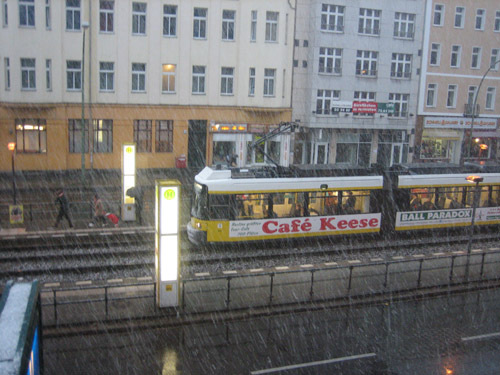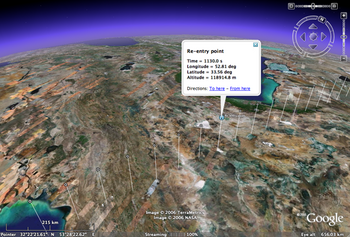This is the the others archive | Back to Main
tobearchived after 6 years
Posted on Monday, September 17, 2012
After exactly 6 years (first post) its time to archive this blog. I've had a great time keeping a trail of my online journeys over these past 6 years and it served me well in my worldly travels, but its time for a new itinerary. I will keep the content up for the Google but I won't be posting here anymore. If you're interested in staying connected, follow me on Twitter @tobedetermined until I find a new home to share my current and future travels.
Bill Joy TED talk
Posted on Thursday, July 15, 2010
Watching this TED video made me end up watching this embedded TED talk by Bill Joy. I remember the article he refers to in Wired back in 2000, 'Why The Future Doesn't Need Us'. I believe I made 20 copies of it and handed them out to my friends in Amsterdam at a film screening I organized.
Space Definitely Was A Place Once
Posted on Friday, February 6, 2009
On my way to Amsterdam I ran into the excellent exhibition "Out Of This World" at the San Francisco Airport (SFO):
Few people today can recall how fantastic the dreams of outer space were prior to its exploration. The knowledge gained from repeated trips into space has largely eclipsed the wild conjecture about the strange planets existing beyond our atmosphere, the beings we would encounter, and the spacecraft that would take us there. But before space was explored, it had to be imagined. The inspired ideas of space exploration and future technologies are vividly reflected in the related toys and household products that permeated American popular culture in the early to mid-twentieth century.
The accompanying brochure is available here. Some more personal impressions @ flickr.

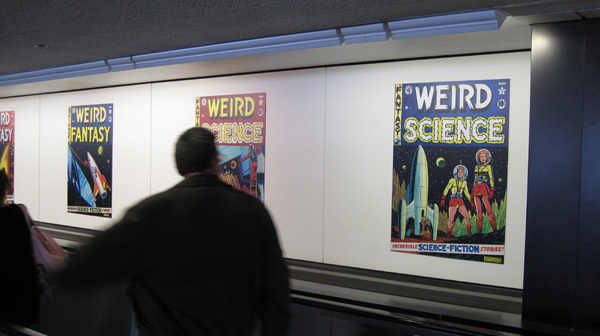

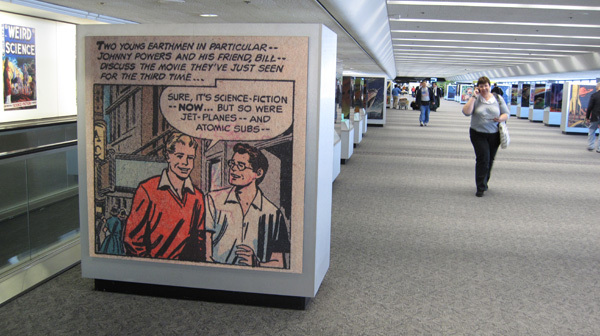
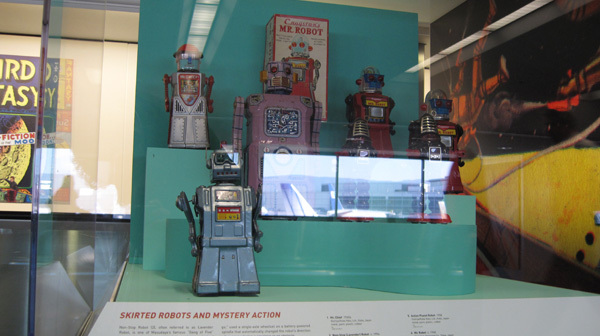



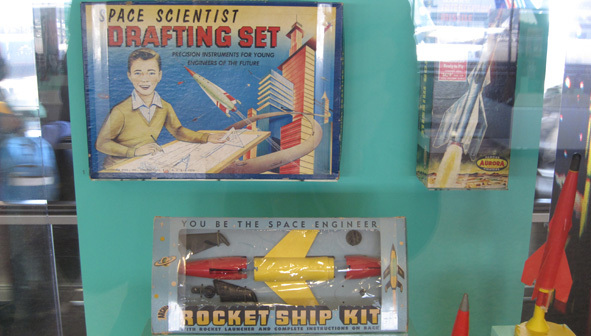
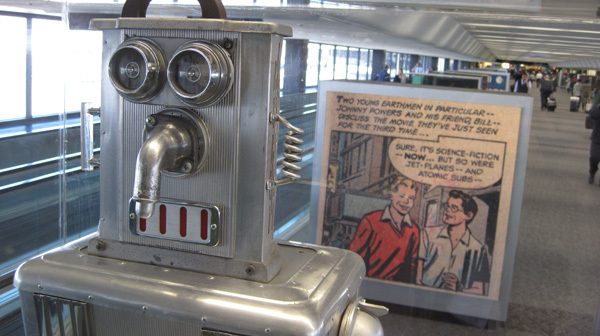
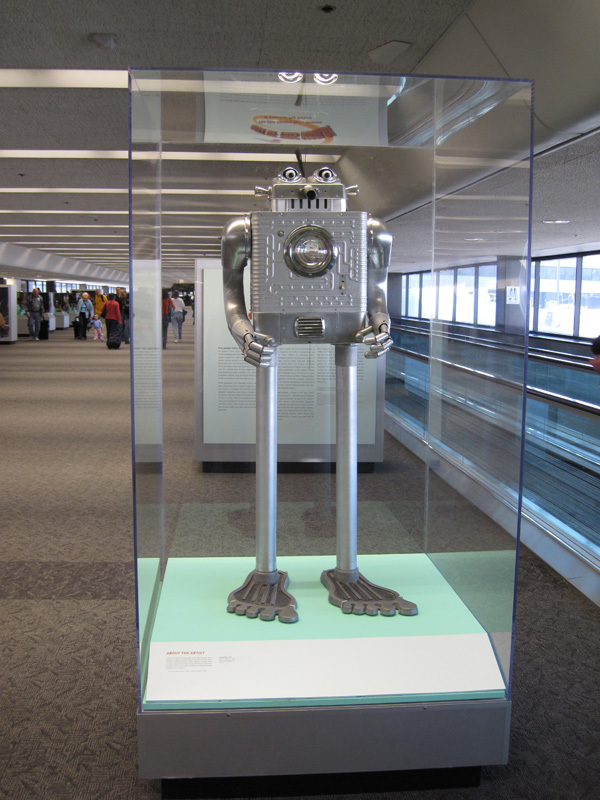
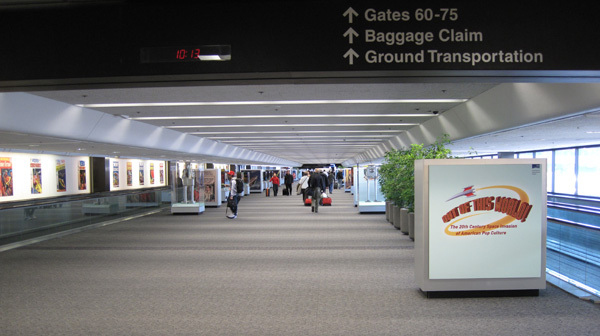
Ceci N'est Pas Un Galaxy...
Posted on Saturday, January 24, 2009
...as Magritte was font of saying :
Magritte painted the pipe "This is not a pipe" (Ceci n'est pas une pipe), which seems a contradiction, but is actually true: the painting is not a pipe, it is an image of a pipe. (In his book This Is Not a Pipe French philosopher and critic Michel Foucault discusses the painting and its paradox.) (((copied from wikipedia)))But it looks darn close I've heard, this full res version of Hubble's interpretation of it.

Silicon Valley is Alive!
Posted on Friday, December 19, 2008
Did I mention Silicon Valley is alive? Its true! When you hang around the bay area (the South Bay that is...), you'll see the airplanes lining up for the landing in SFO or OAK every night of the day. Its one of those views I originally shared with Chris Kemp, CIO of NASA Ames, back in 2006, which made me want to come to the Valley. With the San Mateo Bridge on your left, you'll see a night sky filled with airplanes ligning up to land. Its like living in the future. Its like survival. Its like the human condition in all its splendor: humankind will evolve, whether you like it or not!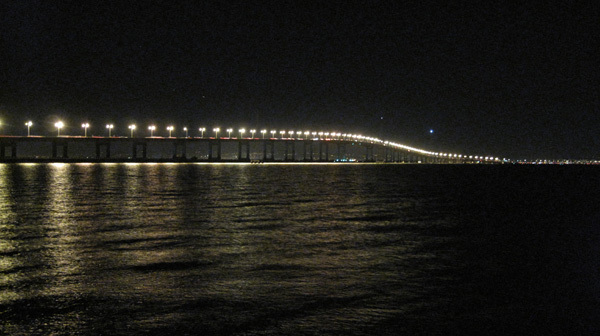
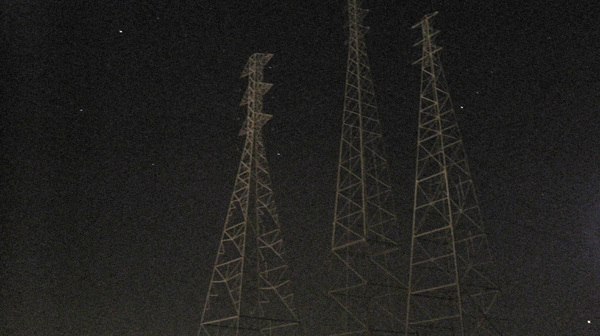
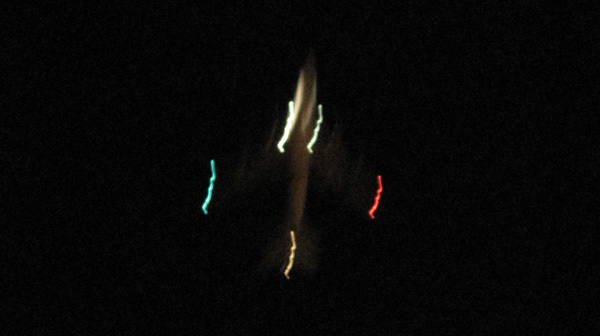
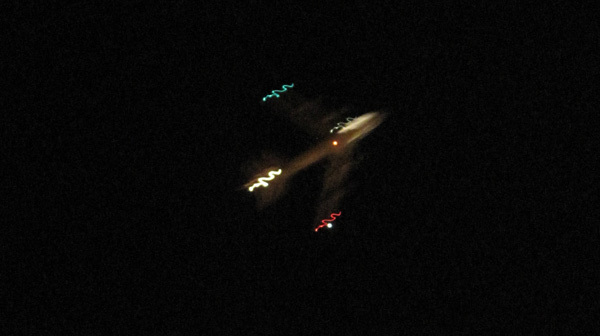
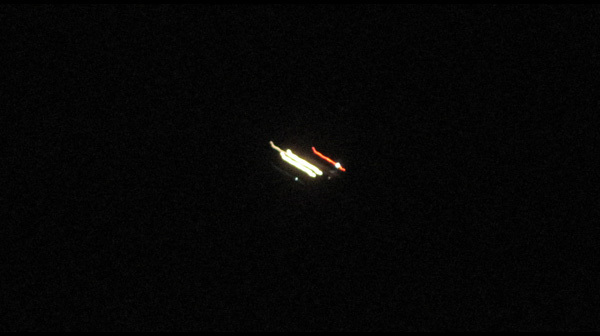
Another Beautiful Day in SF (today's pitstop #8)
Posted on Sunday, November 16, 2008

Click image to enlarge ::: location on Google maps
Autumn in the Valley (today's pitstop #7)
Posted on Sunday, November 16, 2008
How big a change from autumn in Amsterdam, where its probably raining cats and dogs right now. Weather here in the Valley has been perfect today, feels like summer with beautiful trees. Below are a few snapshots I took from the Hoover Tower on Stanford campus yesterday while attending the Open Source unconference, co-organised by a former NASA Ames collegue. The view is towards Southbay, with Palo Alto on the left of the image, and NASA Ames in the middle, noticable by the big hangers (click panorama image to enlarge). More images here. Google map with locations of all pitstop posts embedded below.
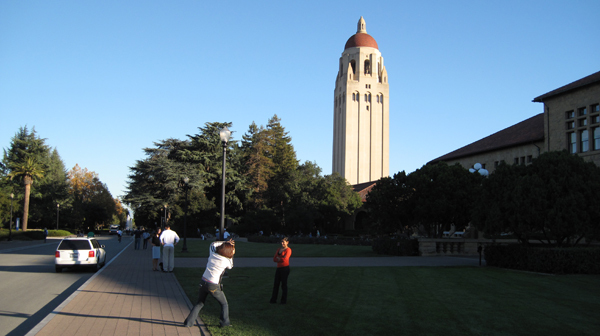
View Larger Map
History by Magazine Covers
Posted on Thursday, October 23, 2008
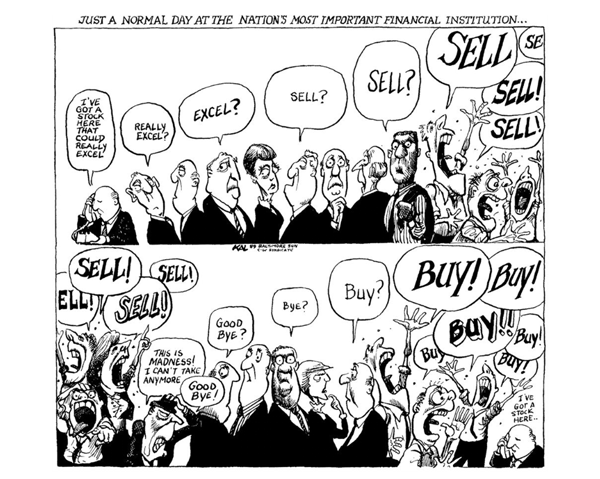
From this presentation of The Economist Magazine covers ;-) (embedded below).
10 Bucks Well Spend
Posted on Wednesday, September 24, 2008
Following on from yesterday's syndication of Tim O'Reilly's keynote at the NY Web2.0, I just finished watching the documentary he has been pointing out on several of his keynotes: A Crude Awakening: The Oil Crash. Buy it on itunes from their website and have a peak into the future of post cheap oil society. Quite informative...
Tim O'Reilly's Call to Action
Posted on Tuesday, September 23, 2008
And it ain't throwing sheeps. From last week's Web 2.0 Expo in New York entitled "Web Meets World".
(via)
tobedetermined.org Extended Credo
Posted on Monday, September 1, 2008
Update: A post over at O'Reilly Radar by Nat Torkington reminds me of another quote I've used in the earlier days of this blog. It's a (famous) quote from William Gibson: The future is here, its just not evenly distributed yet. In his post, Nat refers to another quote from Gibson that brings the overarching point home:
One of the things our grandchildren will find quaintest about us is that we distinguish the digital from the real, the virtual from the real. In the future, that will become literally impossible. The distinction between cyberspace and that which isn't cyberspace is going to be unimaginable. When I wrote Neuromancer in 1984, cyberspace already existed for some people, but they didn't spend all their time there. So cyberspace was there, and we were here. Now cyberspace is here for a lot of us, and there has become any state of relative nonconnectivity. There is where they don't have Wi-Fi.
Having a 3-day weekend does have its benefits (like in: having an extra evening behind your computer?). Think I just stumbled upon something like an extended credo for this blog (beyond tobedetermined.org: A blog about outer space, cyberspace, their common future and all that is leading up to it... ). I started gathering some quotes that resonated with me over the years and ended up with this list (read from top to bottom, in that order):
I am sure there are more out there that would fit this list, so if you have any suggestions pls let me know.
Its the Valley alright
Posted on Thursday, August 28, 2008

Notice the little feet ;-). On the 101 on my way to work today.
War on Terror The Sequel
Posted on Tuesday, August 19, 2008
My brother works in the advertisement business back in Amsterdam. Yesterday he send me below "movie trailer" he recently made for the H20 film festival. Lip sync isn't brilliant, but the storyline soon takes over. Which reminds me that I've been watching a lot of 'Der Untergang' spoofs lately, like this TechCrunch one. As an aside, yesterday I saw this 'hot-of-the-Siggraph-press' video of Microsoft Research into new video editing techniques.
FriendFeed: the Network of Social Networks
Posted on Saturday, August 16, 2008
I am late to the game, but having signed up just 5 minutes ago, I already like FriendFeed a lot. My feed brings together this blog, my delicious tags, my twitters, my facebook account, (not my Hyves account...ah, who cares about Hyves), my Flickr account, my Linkedin account and my Youtube account. See below for an interview with co-founder Bret Taylor.
Summer 2008
Posted on Friday, August 1, 2008

Back from a week of Internetless holiday on the island of Korcula (above photo was at Koln airport just before we were told we could board the plane ;-). Catching up here are a few relevant tidbits:
- The Economist's commentary on NASA's 50th anniversary provides a sharp dissection of NASA's past, present and future. Its the most sensible story on space and NASA I've read in a long while. As always, the comments are worth reading too, if only to see how space proponents bring their arguments into gear to downplay the article's 'hammer on the nail' analysis
- Sanfran article of the week about twitter, relationships, and the bay area working spirit
- Missed OSCON, but here's a 37min intro and Tim Oreilly's comments
- A great discovery: this TED video by kevin kelly. I especially like his McLuhan Reversal analogy. Have to watch it again.
The Stone Age Didn't End Because of a Shortage of Stones
Posted on Sunday, July 20, 2008
Bruce Sterling comments inline on this passionate call by Al Gore for the US to become carbon fuel independent in 10 years.
Time to put some solar panels on my roof here in Palo Alto. Or wait, wasn't I first gonna spend 2 weeks flying around Europe for my holiday, buy the iPhone and upgrade my car (from what I hear SUV's come cheap these days).
Could this be the "Moonrace" of the 21st century?
We need you. And we need you now. We're committed to changing not just light bulbs, but laws. And laws will only change with leadership. On July 16, 1969, the United States of America was finally ready to meet President Kennedy's challenge of landing Americans on the moon. I will never forget standing beside my father a few miles from the launch site, waiting for the giant Saturn 5 rocket to lift Apollo 11 into the sky. I was a young man, 21 years old, who had graduated from college a month before and was enlisting in the United States Army three weeks later.I will never forget the inspiration of those minutes. The power and the vibration of the giant rocket's engines shook my entire body. As I watched the rocket rise, slowly at first and then with great speed, the sound was deafening. We craned our necks to follow its path until we were looking straight up into the air. And then four days later, I watched along with hundreds of millions of others around the world as Neil Armstrong took one small step to the surface of the moon and changed the history of the human race.
We must now lift our nation to reach another goal that will change history. Our entire civilization depends upon us now embarking on a new journey of exploration and discovery. Our success depends on our willingness as a people to undertake this journey and to complete it within 10 years. Once again, we have an opportunity to take a giant leap for humankind.
Too Funny
Posted on Friday, July 18, 2008
God, did I miss Jon Stewart when he was on holiday. Watch this from the beginning and be ready for an apotheosis starting 07:20 (btw, I believe Hulu is only available for American viewers).
Yup
Posted on Thursday, July 17, 2008
Wading through +2k unread posts in my list of RSS feeds (Bruce Sterling's Beyond the Beyond).
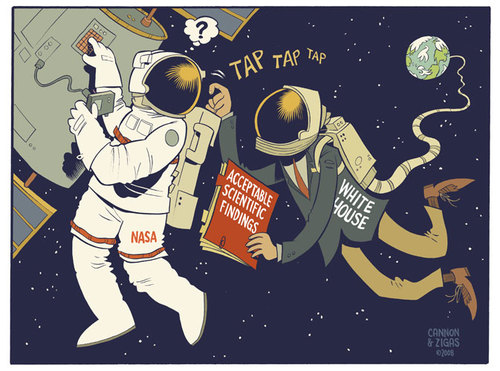
Its You They're After
Posted on Saturday, July 12, 2008
The best analysis on Google's Lively I've read sofar comes from RealityPrime: Its not so much about giving people a nice virtual world to play with, its providing a new interface to harvest new and previously untapped user behaviour. Which reminds me of an excellent article I was send the other day on the near future of advertising, a must-read.
Its iPhone Time in Palo Alto
Posted on Friday, July 11, 2008
Just around the corner from where I live there is the Apple store on University Avenue. Not too big a crowd, mostly Stanford students playing guitar hero while the press anxiously awaits whats to come. I decided to opt for a roundtrip to Amsterdam instead, an alternative which also doesn't come cheap these days. But first its Mechanicrawl this saturday up in the City.
Windy Hill Overlooking the Bay Area
Posted on Thursday, June 26, 2008
![]()
Click to Enlarge
Last weekend I finally found what I was looking for the first few weeks I arrived here: on top of a hill, a place to at the same time overlook the Pacific on one side and the Bay Area on the other (Thanks Deborah!). If you look closely, you can see the City (SF) in the far end of the Peninsula (follow the Bay to the left, the City is just visible before the hills start) and Stanford in front (the tower). At the end of the Bay (to the right), you can see the large windtunnels of NASA Ames. Further to the right is San Jose.
To make things easier, see below for the exact location on Google Maps from where I made the panorama.
And the folks in the image....uhm...they happened to be there as well ;-)
View Larger Map
Steve Jobs Down the Road From Here Back In 2005
Posted on Tuesday, June 24, 2008
Friday Afternoon Yawns
Posted on Saturday, June 7, 2008
OgleEarth is on the ball with his critique on Walt Disney Park's layer in Google Earth being 'the next best thing to being there'. Reading it, I recognise I am reading my own unexpressed yawn about it (without having had a look at it myself I do admit, but that tells it all I guess). A virtual Disneyland devoid of people, and no possibility to take a ride, WoW!? If only I had some time to go back to the enthusiasm while working on UGO, but for some reason, its not that attractive at the moment. Even with the ability to bring it into the browser, which is pretty cool yes, apart from the techno fetish, there's at the moment not much occasional inspiration to throw time at Google Earth (apart from learning the javascript GE API implementation perhaps). Has anybody heard anything about Second Life lately btw?
On a more enthusiastic note, I attended the Google I/O conference 2 weeks ago here at Moscone West. Now that was exiting! Not so much from a Google Tech or developers point of view (albeit that was pretty inspiring too, mostly diving into the Google App Engine, on which I had my first encounter with the GE browser plugin), but more from a cultural real people point of view. Apparently they brought Google culture over from the Googleplex to the conference center. I lost my camera in the meantime so can't show you my pictures of all the beanbags, free food, and other goodies, but man, that's a sweet company culture (and flickr tags are there to prove it). And a young crowd too.
I recognised the same kind of culture here at Yahoo HQ earlier this week where we were sitting in on a meeting on the upcoming Yahoo Hackday. Working at a place where the coffee corner closes 30 minutes after lunch has been served (that's around 2:00pm folks), and where the cappucino comes out of a prefab instant-make coffee-crap-machine, I am all for Google joining the ranks here on the NASA Ames premises. And I certainly hope some of their culture bleeds over the fence into Ames, which I'm sure it will (not sure if i'll be around to witness it though as they only start building in 2013).
As usual, these high profile Google announcements draw quite a bit of cynical critisism from the likes of Bull's rambles, Valleywag and ZDNet but that's as yawn inspiring as the Disney layer in Google Earth.
My two cents for the weekend: Ask not what Google or Yahoo! can do for you, but what Google/Yahoo! culture can do to your space program.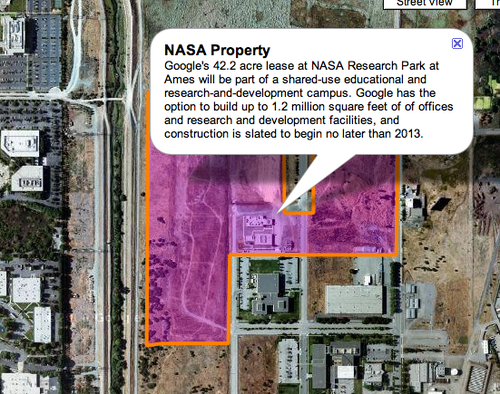
(see it in google maps, or, if you really really want to, in Google Earth)
View Larger Map
Intergalactic TV
Posted on Wednesday, June 4, 2008
Doing some research on NASATV (wikipedia) I come across a couple of other space agency TV stations, like ESA's (boring not much happening there) and this one from the Russian Space Agency. On the latter, I am welcomed by Mr Ostrovsky, Head of Roscosmos-TV (below). Reminds me of a Dutch show. Too bad they don't have regular TV webstreams ;-).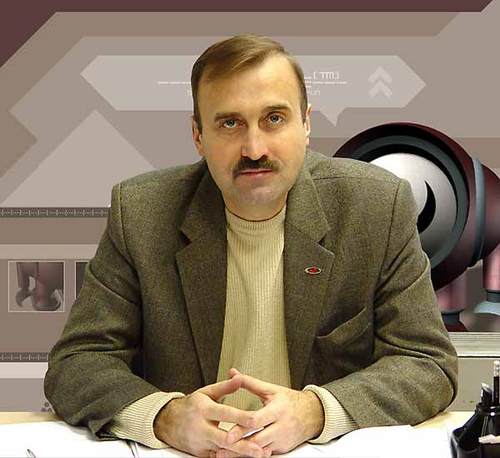
US culture in the US
Posted on Saturday, May 24, 2008

Haven't had a chance to watch movies since I moved to the US, let alone good movies, like these, or this one, and this one. That changed 5 minutes ago when I finished watching The assasination of Jesse James by the Coward Robert Ford. Wow, what a great film! And what a great pleasure watching it. Damn, I love good cinema!
Some views to enjoy (until I get back to posting regularly)
Posted on Tuesday, May 6, 2008
web2.0 Expo day 2
Posted on Thursday, April 24, 2008
Today is the second day of the Web2.0 Expo here in San Francisco. It keeps getting better. And busier. Below is a (very) brief impression: morning sessions (including this one on Yahoo answers and their open source platform), the Expo Hall (times 4), and a demonstration marketing for a new mindmapping2.0 tool. The afternoon keynotes are coming in a separate post.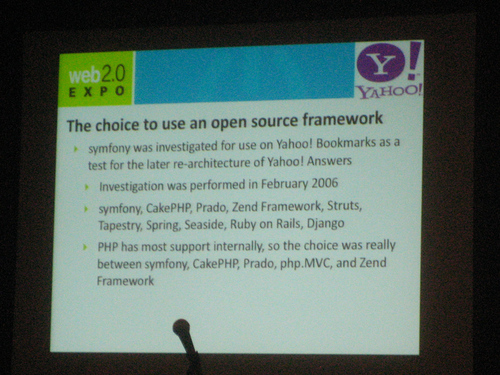
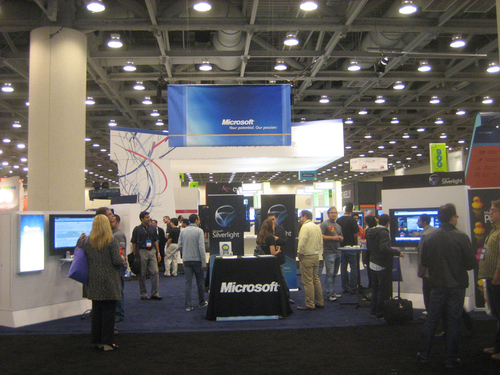
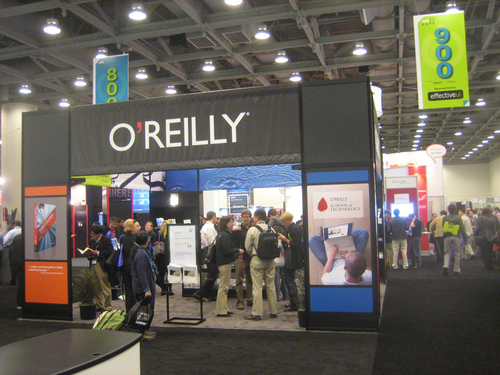

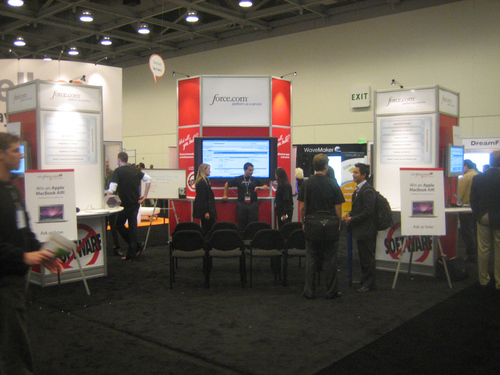
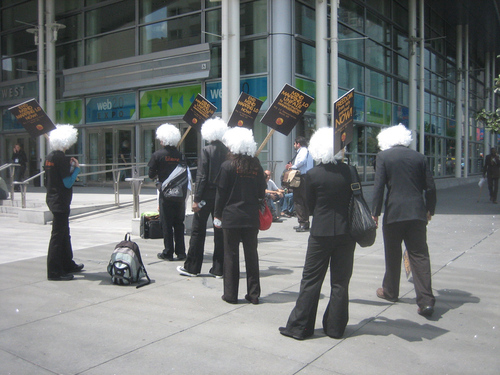
A.C. Clarke died today
Posted on Wednesday, March 19, 2008
...(bbc news)
update: Google's Chief Evangelist Vint Cerf also says goodbye to Clarke in this post. It includes a nice video of Clarke recorded end of last year.
Craig Venter @ The Long Now
Posted on Wednesday, February 27, 2008



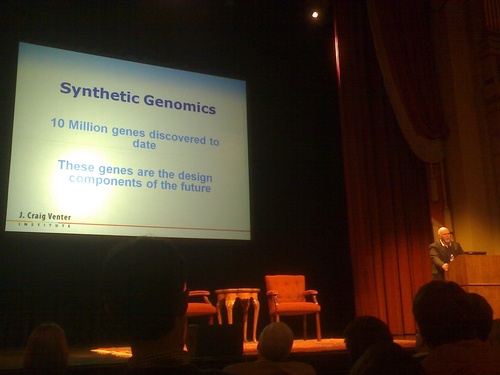
After watching online seminars for over a year now, yesterday I finally got a chance to visit a Long Now seminar in person down in San Francisco. And guess what..!? I was on their guest list ;-) Ever since I learned about The Long Now Foundation over a year ago, I've been a fan. So when I was offered a chance to become a charter member last year, I didn't hesitate. Even got me one of those metal plates the size of a credit card. Plus my name on their guestlist. #518 I am.
So here I was, first choice in seating, amongst all those people I've been learning about by reading a wide variety of blogs over the years: Kevin Kelly, Peter Schwartz, John Brockman, Stewart Brand, Chris Anderson etc. Having arrived in the US only a few days ago, I was clever enough to take my camera battery charger with me while jumping in my car here in Mountain View to head over to SF, only forgetting to realise it only has a European plug. With the battery depleted before arrival in San Francisco (driving the 101 makes for perfect filming scenery ;-), I was left with only my Sony Ericsson P990i phone camera to make some snapshots of the lecture and the audience. Overall, Craig Venter was pretty straightforward in his view on the coming age of biotech. Or, as Stewart Brand put it in his short summary emailed around after the event:
To really read DNA accurately and understand it thoroughly, you need to be able to write it from scratch and make it live, Venter explained.
His sequencing the first diploid human genome (with the genes from both parents) last year showed there is much more genetic variation between humans than first thought. His current goal is to fully sequence 10,000 humans and bring the price for each sequence down to $1,000. With that data, his says, "We'll begin to really learn what's nature and what's nurture."
"Microbes make up one half of the Earth's biomass." Venter's shotgun sequencing of open-ocean microbial samples revealed that every milliliter of ocean has one million bacteria and archaea and ten million viruses even in supposedly barren waters. Taking samples on a round-the-world sailing trip showed that every 200 miles the genes in the microbes are 85% different.
"Microbes dominate evolutionary diversity," Venter said. Some 50,000 major gene familes have been discovered. Humans and other complex animals have a small fraction of that in our own genes, but the "microbiome" of our onboard microbes carry the full richness. Only 1/10th of the cells in a human are human; the rest are microbes. There are 1,000 species in our mouths, another 1,000 in our guts, another 500 on our skins, and those with vaginas have yet another 500 species.
Analysis has shown that a tenth of the chemicals used in our body come to us via our gut microbes. "We are what we feed our bacteria and what they give us."
In an effort to determine what is the minimum gene set for life, Venter's team took a 500-gene bacteria and began knocking out genes. They got the viable set down to 400 and realized that the only way they are going to understand the complexity is by mimicking it. They would need to synthesize a working genome artificially, first on a computer and then with assembled base pairs and "boot it up" in a living cell, making a new, unique species. They devised techniques that repaired errors during synthesis, and they demonstrated that a genome from one kind of bacteria could be implanted in another and come to life there, changing one species into another. "It was true identity theft."
"This software builds its own hardware," Venter marveled.
He emphasized that synthetic biology does not re-do Genesis, but it does offer a kind of Cambrian explosion, building on 3.5 billion years of evolution to go in an infinity of possible directions. The range of possibilities is indicated by an existing organism that can take 1.75 million rads of radioactivity in 24 hours, which explodes its genome. It can reassemble the shattered genome and live on. It can go dormant for millions of years, and live on. That means life may already have migrated between planets.
Venter proposed that our current energy and climate situation requires truly disruptive technology. One project he's working on would use altered microbes to metabolize coal in the ground and generate methane, for a tenfold increase in carbon efficiency. Another project proposes a "4th generation biofuel," where engineered algae directly convert CO2 into hydrogen in bioreactors.
"Ten million genes are the design components of the future," Venter concluded. "With combinatorial genomics and casette-based construction, we can make millions of genomes per day."
During the Q & A I asked Venter why he spends so much of his time speaking in public, 150 talks a year. He said he sees that as part of his scientific work, to prepare the public for the big changes coming. He wants to avoid repeating the mistakes made with genetically modified crops (GMOs), where there was insufficient transparency and regulation, and irrational opposition by environmentalists, which crippled a crucial field.
The public should feel it is included in every stage of genetic science and emerging biotechnology.--Stewart Brand
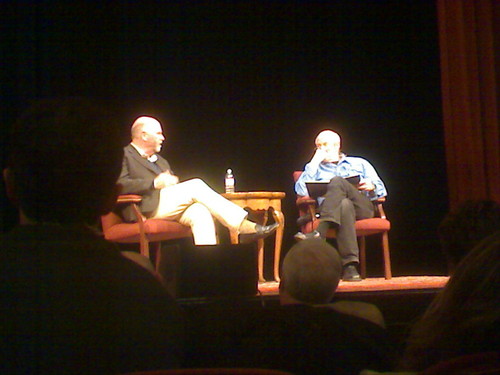
Time to get on the bus
Posted on Wednesday, February 27, 2008

Ok, so its time to give a brief update on my (physical) whereabouts. Since last thursday I moved from Amsterdam to Mountain View, Silicon Valley to work with Chris Kemp and his collegues over at NASA Ames starting next monday March 3rd. Weehoo! Finally, a long held dream is coming true, taking part in the upcoming merger of outer space and cyberspace, right at the heart of where all things space are happening. Couldn't be better!
As for this blog, looks like I will be using it from now on to give you a personal insight in my personal and professional experiences here in the Valley. Sofar, these include a great arrival and first few days enjoying the Bay Area rainy season (yes, it can rain here...), a visit to the Vertical Motion Simulator on NASA Ames premises last friday (for photos have a look at this flickr album), my first NASA vrimibo with Ames director Pete Worden, Chris Kemp and several of my upcoming collegues (vrimibo is short for 'vrijdag middag borrel', Dutch for the traditional friday afternoon drink), a first counter-clockwise drive around the Bay Area, and writing off the first item on my wishlist of things-to-do-when-I-get-to-the-Bay-Area: attending a Long Now seminar in San Francisco (on which more in a follow-up post).
And the 14 Challenges go to...
Posted on Sunday, February 17, 2008
The Grand Challenges for Engineering in the 21st Century. These challenges have been announced Friday February 15th by a Committee including names like Kurzweil, Page, and Venter. Outer space is one of them, but only via the somewhat non-descriptive Challenge to 'Engineer the Tools for Scientific Discovery'. Cyberspace on the other hand gets its own Challenge to 'Enhance Virtual Reality'.
Evolution in Electricity Tubes
Posted on Thursday, January 10, 2008
Another nice video from TED, this one from a fellow Dutchman: Theo Jansen (thanx Nadav).
Solar Cycle 24
Posted on Thursday, January 10, 2008
Some topics passing by:
- In case you missed it, Solar Cycle 24 just started
- MDA (Canada's biggest satellite business) gets sold to US defense contractor
- The Arts Catalyst blog has recently emerged. From their blog:
The Arts Catalyst commissions art that experimentally and critically engages with science. We bring together people across the art/science divide and beyond to explore science in its wider social, political and cultural contexts. We produce provocative, playful, risk-taking projects to spark dynamic conversations about our changing world.
- A lot of good text over at Edge, following this year's question 'What have you changed your mind about? why?'. Sofar, this entry by Douglas Rushkoff stood out:
The Internet
I thought that it would change people. I thought it would allow us to build a new world through which we could model new behaviors, values, and relationships. In the 90's, I thought the experience of going online for the first time would change a person's consciousness as much as if they had dropped acid in the 60's.
I thought Amazon.com was a ridiculous idea, and that the Internet would shrug off business as easily as it did its original Defense Department minders.
For now, at least, it's turned out to be different.
Virtual worlds like Second Life have been reduced to market opportunities: advertisers from banks to soft drinks purchase space and create fake characters, while kids (and Chinese digital sweatshop laborers) earn "play money" in the game only to sell it to lazier players on eBay for real cash.
The businesspeople running Facebook and MySpace are rivaled only by the members of these online "communities" in their willingness to surrender their identities and ideals for a buck, a click-through, or a better market valuation.
The open source ethos has been reinterpreted through the lens of corporatism as "crowd sourcing" — meaning just another way to get people to do work for no compensation. And even "file-sharing" has been reduced to a frenzy of acquisition that has less to do with music than it does the ever-expanding hard drives of successive iPods.
Sadly, cyberspace has become just another place to do business. The question is no longer how browsing the Internet changes the way we look at the world; it's which browser we'll be using to buy and sell stuff in the same old world.
Paul Saffo at the Long Now
Posted on Monday, January 7, 2008
If you're in the SF Bay area, Paul Saffo is giving a talk at the Long Now Foundation this Friday.
Happy 2008 Everybody
Posted on Monday, December 31, 2007
A quick last post before the fireworks. While making dinner I was listening to this talk by Douglas Engelbart at the Accelerating Change Conference 2004. Great talk, especially the way he talks about tools and how they changed society over the centuries and will continue to change our societies in the future. Nice thought to start the new year ;-)
Tugunska Asteroid Simulation
Posted on Saturday, December 22, 2007

Where 50 years of atomic bomb simulations pays off. Beautiful! Check out these videos at Sandia Labs.
Digistuff
Posted on Monday, November 26, 2007
Alexander van Elsas points to a flickr set with some nice quotes. They're not all that great but enough are interesting to wade through. Here are a few of my favorites.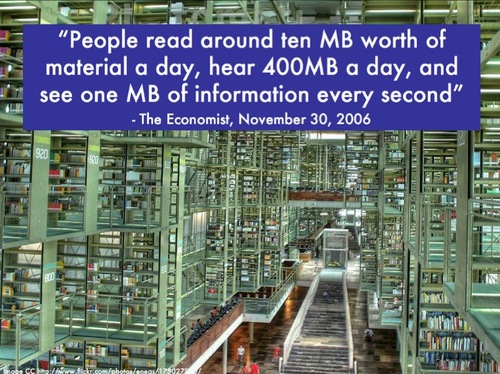


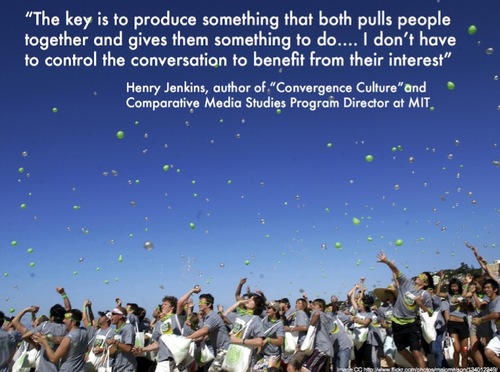
Geofencing
Posted on Tuesday, October 16, 2007
Doing a quick internet scan on GPS enabled devices, I run into an interesting term: Geofencing (e.g. here). Makes me think of draggin' a route on Google Maps.
Evo Devo IntelliDeso...Mutating Pictures
Posted on Friday, October 12, 2007


Dawkins' book 'The blind watchmaker' has an extensive discussion of how evolution walks through the solution space of an evolving artificial species. Above images from Mutating Pictures are a nice example of this when you take it to the web for people to do the selection (via Google Blogoscoped).
DinnerTV: Facebook meme
Posted on Monday, October 8, 2007
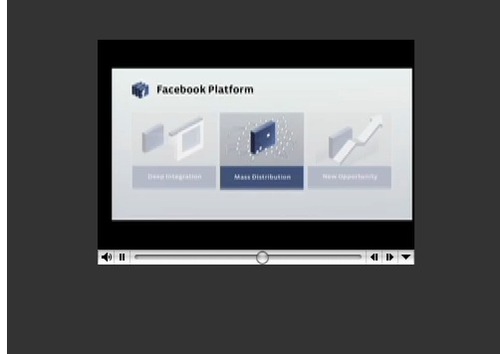
A few weeks of relative unplugged quality time and whoop, you're missing the 'next big thing' on the Internet. It took a while, but I finally spent some time reading up on the Facebook meme. Mmm, interesting, a pagerank Social Graph view on people instead of websites...For a good intro, read this, make an account here, and have a look at this video with Mark Zuckerberg talking about the Facebook platform for developers (not sure if I like his version of the Steve Jobs style though...).
DinnerTV: South Park meets World of Warcraft
Posted on Thursday, September 13, 2007

I just read that one of the best pieces of television in a looooooooooong time has just won an Emmy (in Dutch). I've watched it over and over again, and for once this episode remains funny even after seeing it more than 10 times. Strangely enough, I've never found a good version on the Internet to share with you...until now. If you can handle the somewhat lower resolution and the annoying logos flying in and out of the screen in this 'official' online version (is YouTube going to be like this? I hope not!) then enjoy: South Park meets World of Warcraft (be sure to check the full screen button).
Banking the Internet
Posted on Friday, August 31, 2007
Google in the economist tells us that Google's rapid ascent and its role in the market more resembles a bank than Microsoft (via), while O'Reilly Radar talks about infovis and similarities between web2.0 and financial markets. In essence, a quick friday afternoon post.
User Generated Content Generator, aka a human being
Posted on Monday, August 13, 2007
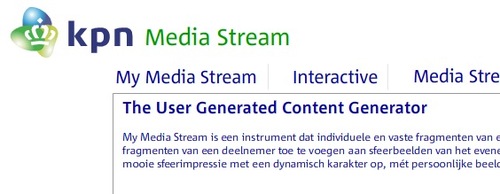
Talking to a friend here in Amsterdam who is in the online video business (MyVidayo), he points me to a website with the term 'User Generated Content Generator' (click My Media Stream)...what is that all about? Recursion? Abstraction? Web3.0? Agents? Meanwhile, Tim O'Reilly posts an insightful list of quotes.
Signs of Singularity: The Floraweb Is Coming
Posted on Friday, August 10, 2007
Are you ready for the Floraweb? Then watch below video ;) (via O'Reilly Radar):
Earth Polar Lander mission
Posted on Thursday, August 9, 2007

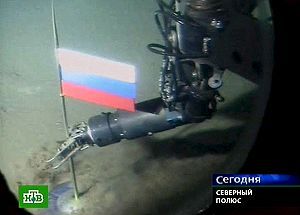
Who'd expected that "exploration" would be taking place so close to home? I know its late in coming, but I just gotta blog/archive this for the shear resemblance of the undertaking to the 'traditional' space paradigm. Just the images are a brilliant PR stunt. Reminds me of the film 'The Wild Blue Yonder' by Werner Herzog.
SciFoo
Posted on Thursday, August 9, 2007
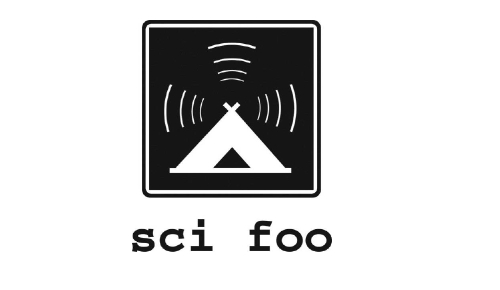
Update from Duncan Hull (keep me posted Duncan!):
There is talk of EuroFoo, probably to be held in Cambridge. There will also be "bar camps" again, in Cambridge and soon in Manchester.
Man, I wish they'd bring SciFoo over to Europe, how cool is this ? To get a taste, have a look at this Flickr series ! Maybe a SpaceFoo? Probably a bit too exciting for ESA, but ISU perhaps?
LinkedIn, Facebook, Hyves (the worst UI of all times)...
Posted on Thursday, July 26, 2007
Where is my social network of networks?
Twitter As The Sixth Sense?
Posted on Wednesday, July 25, 2007
I have some vague but strong memories of reading a book as a kid where on another planet a civilisation evolved to a state where they could communicate via telepathy. In my memory, this way of communication felt surprisingly natural, so natural even that I hardly took notice of the fact that it was actually way off from the way we normally communicated on this planet in the 20th century...
Fast forward to 2007: mixing up web2.0 with space explo (or the other way around) is being discussed at the participatory explo workshop at Ames. Reading this 26June Wired article 'How Twitter Creates a Sixth Sense', I can totally dig it. Consider walking around your local supermarket and getting twittered by your favorite Moon explorer having a picnic on the Moon with a view of the Earth. Now that's what I call stretching the mental picture. Preferably the Astronaut2.0 will also send me some live images of the Earth, but that's another story...Btw, do machines twitter? (via MarketingFacts)
Sicko
Posted on Tuesday, July 3, 2007

Not related but worth watching: Michael Moore's Sicko (removed from Google Video but available as Google Player file through this post).
Update: some more interesting titbits @NYT @GoogleBlog on the Google Sicko story.
The developing story on this Google Health blog post is very interesting and gives some clues about what happens when the question is on the medium itself...what if Google were to take out all news on this story, or calls Digg to bury the story in their listing, or removes all search results to related types of queries...interesting stuff, like the ongoing comments over at this Google Blogoscoped post show.
Btw, I can imagine living in France is a blesh when it comes to healthcare, but striking the living daylights out of your own economy doesn't do anybody good...guess as always its a more complicated story than can be said in an enjoyable documentary (how he gets Guantanamo in there is just a great piece of dramatic storytelling).
Transvision2007
Posted on Friday, June 29, 2007
Wanna know what some smart people are thinking about a couple of relevant topics to humanity, e.g.:
Day One: Inner space: Transforming Ourselves
Longevity, Life Extension, Nanotech, Nanomedicine, Bionics, Biotech, SENS, Cryonics
Day Two: Meta space: Transforming Humanity
Environment, Global Warming, Sustainable Housing, Alternative Energy, AI, Robotics, Virtual Reality
Day Three: Outer space: Beyond the Planet
Future Humans, Colonizing Outer space, Space Tourism, Future Civilizations
Than this Transvision2007 get-together might be something worthwhile paying a visit. Being in Europe, its a bit to far for me to hop in, but I definitely look forward to some post-event DinnerTV videos at their site. I read here that Kurzweil is even planning to experience zero gravity in one of ZERO-G's airplanes...
Btw, running the risk of being cheesy, I think this photoshop job at their website is kinda funny as it reminds me of the many 'Second Life chat meeting' images that are currently circulating the web (like below one from an amazon webservice chat session). Why don't we all be seated next to a geostationary satellite's optical camera and let the Earth do the talkin'...;)

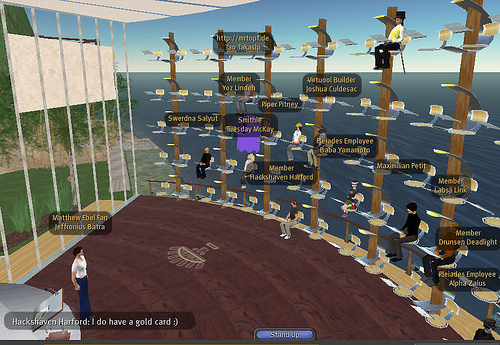
Light posting ahead
Posted on Saturday, May 12, 2007
Haven't been very active on this blog lately, which is mainly due to my full focus on the development of my UGO project, making me less susceptible to reading my section of the blogosphere on all the news coming out on a daily basis. I haven't finished my first build yet, so this light posting will likely continue for the coming days/weeks untill I finalise a first UGO app. In the meantime, some interesting developments worth noting:
- Search Engine Land (definitely a good read)
- a joke
- Anil Dash post
- News.com
And of course there is the news of a new WorldWind JAVA release.
Updated blog feed
Posted on Tuesday, May 1, 2007
Mmm, turns out I already had a FeedBurner account with several subscribed readers to this blog (re: earlier post). Strange how things like feeds can get this complicated...;) Anyway, to keep things organised I decided to delete the new account and merge its feed with the already existing one. For those of you who subscribed to the new one in recent weeks, please visit my blog's webpage and (re)-subscribe one more time to the FeedBurner link on the right.
To check if you have the correct feed, the correct FeedBurner account should now have the following URL: http://feeds.feedburner.com/tobedetermined (for Safari on OSX this should read: feed://feeds.feedburner.com/tobedetermined)
Thanx again...
Ray Kurzweil
Posted on Monday, April 16, 2007
in case you missed it, this video gives a 23 min run-down of Ray Kurzweil's thinking. Its from February 2005, so its lagging a couple of paradigm shifts, but nonetheless...
Feedburner feed to tobedetermined.org
Posted on Sunday, April 15, 2007
Ok, ok, so I may have accidentally included a Safari-based feed-link a couple of months ago...But guess what...I finally fixed it -> see on the right. If you're interested, please be welcome to subscribe to this blog through Feedburner. Thanks.
Thank God For The Internet
Posted on Tuesday, April 10, 2007
Not sure where I got the quote from Bruce Sterling that has been sticking with this blog for quite some time now (The future Is Process, Not A Destination) but I just found a new one which again fits well with what I am trying to get my head around here (albeit a bit too long to replace the older one):
"A computer interface for everything in the world: that doesn't sound realistic but that's because i'm a visionary, it's not my job to be realistic! Something like that is going to happen. It's going to be difficult but you're going to do it. And you will be getting a lot of money when you succeed in doing a part of it."His talk here in Amsterdam recently wasn't all too exciting, especially compared to when he really gets up to steam, like during this one: Bruce Sterling's SXSW 2007 Rant (more where that came from at the SXSW 2007 podcast feed). When you decide to listen to his talk, you might be interested in the following links as well:
Dropping the bomb
Posted on Monday, March 12, 2007
One of the nice extra's of working in the space sector (and currently collaborating with Russian Submarine Launched Ballistic Missile (SLBM) designer SRC Makeev) is the opportunity to sometimes get a little sneak preview into the Russian industrial military complex. One of my collegues from Samara recently wrote me an email announcing his absense in our collaboration because he was going to a conference in a higly secretive town called Sarov:
Yes, I'm back from Sarov, one of the "mail boxes" (i.e. closed secret towns). When I say closed I meen that it's really closed - the whole town is surrounded by fence, with only few check-points. You need a special permission to enter and also another permission to leave! Foreigners should apply 3 months before visit.
In Sarov he managed to visit the Nuclear Weapons museum. All items in below photo are nuclear warheads, with a particularly large one in the back. The second photo shows my collegue in front of the worlds largest fusion bomb. I don't know, but it has a weird kind of 'Tintin' or 'Melies' feel to it. Imagine dropping a bomb like that...
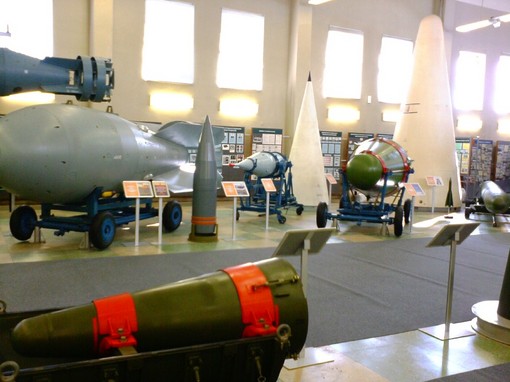
Click to enlarge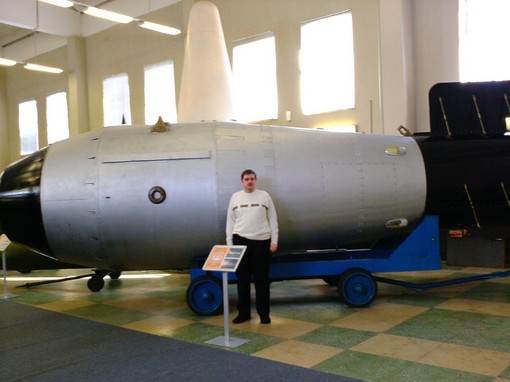
Click to enlarge
You, Science and Recursion
Posted on Monday, February 5, 2007

Part of the video in my previous post corresponds to what Kevin Kelly talks about in this very interesting 1-hour presentation on the history and future of the Scientific Method:
Kevin Kelly
The Next 100 Years of Science: Long-term Trends in the Scientific Method (mp3)
Friday, March 10th 02006.
One of the main points he makes here is the importance of so-called 'recursion' for the Scientific Method. I haven't completely grasped his idea yet (need to listen to the podcast again), but it kind of gives a name to a phenomenon I was wondering about myself a couple of weeks ago. As an engineer, I know surprisingly little about marketing but as far as I can see, basically, with the markets now having become global, there is no 'outside' anymore when it comes to marketing. When we market, we (hypothetically) market to the entire world, that is, the entire human population. Which also includes ourselves...exactly this idea of recursion: the process looks back on itself. So does this mean the nature of marketing will change, and if so, what are the 'meta-models' that will come out of this recursion...? Seems to me virtual globes and alike convincingly portray this recursiveness (like the Apollo 8 did back in the '60) and therefore could play a role in this process. Seems also to have to do something with conciousness, but to make that claim I first need to read Godel, Escher, Bach ;)
Btw, more podcasts from Seminars About Long Term Thinking at The Long Now Foundation are available here.
Web2.0: the ghost and the machine
Posted on Monday, February 5, 2007
(via O'Reilly Radar & Dutch Cowboys)
Jeff Han's multi touch
Posted on Thursday, January 25, 2007
Its been around for a while already (in Internet terms that means what, a couple of days?), but for those of you who haven't seen it: a new video showing the next generation multi touch screen (via OgleEarth amongst others). Here is the article that goes with it.
Tobedetermined finds...Agents of Evolution
Posted on Wednesday, January 17, 2007
- Futurist Peter Schwartz introduces an interesting term new to me in this article: Agents of Evolution
- O'Reilly Radar: Measuring a virtual world and If Google were a restaurant
- How about one of the above cameras onboard the ISS?
- Back to the 50's: China destroys old weather satellite
- Google wants YOU! in Google Earth: Google's Australia Day 2007 aerial photography. Turns out, Microsoft is planning to do the same, with the oh, so Microsofty catchphrase 'Look Up and Smile this Australia Day'
- The archives: Google's Master Plan
yep...the iPhone
Posted on Wednesday, January 10, 2007
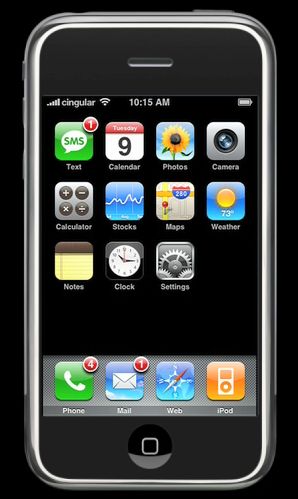
Finally a decent iPod phone...time to put my p990i away (after 1 month of agony already)...oh wait, its only available Q4 here in Europe...June in the States...guess its time to go back ;)
Welcome to the real world
Posted on Sunday, December 24, 2006
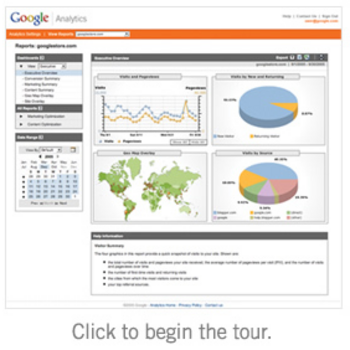
Being relatively new to the blogging game, I am stupéfait about the sophistication of the Google ad machine...take the red pill and have a look at this introduction about Google Analytics. If you ever wondered about monetization of the database of intentions...
The home computer in 2004
Posted on Saturday, December 23, 2006
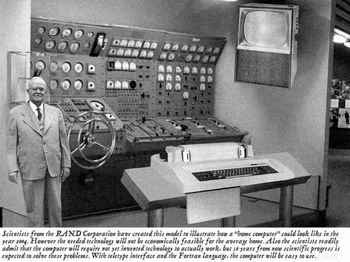
"Scientists from the RAND Corporation have created this model to illustrate how a 'home computer' could look like in the year 2004. However the needed technology will not be economically feasible for the average home. Also the scientists readily admit that the computer will require not yet invented technology to actually work, but 50 years from now scientific progress is expected to solve these problems. With teletype interface and the Fortran language, the computer will be easy to use."
Where do you want to sail to today...? (from urbanlegends.about.com)
YES2 Google Earth
Posted on Thursday, November 16, 2006
Here is another one of my older posts (May '06) which I managed to bring back from digital oblivion by specifically interrogating The Google about my domain name and looking at the cached pages (search string 'site:tobedetermined xxxx'). Its only good for text though, cause other stuff like images is not cached (thanks for the tip Jurryt).
Recovered post:
Following up on my suggestion about the resemblance between the 3D GoogleEarth implementation of the TWA flight-800 disaster and the 2.5D visualisation currently available in YES2's Re-Entry Simulator Tool (REST), Marco Stelzer of the YES2 team at ESTEC has done a great(!) job implementing a REST2GoogleEarth output file option in REST.
The REST simulator, which is part of the larger YES2 mission simulator YESSim, is currently under development for ESA's 2nd Young Engineers' Satellite in order to study and control the landing of the YES2 'Fotino' re-entry capsule. The educational YES2 mission is designed to return a small capsule from space to the Earth using a 30 km long tether. Its launch is currently sheduled for October next year from the Russian launch base Baikonur onboard the Foton M3 spacecraft.
One of the REST2GoogleEarth output files developed by Marco provides an elegant display of the re-entry trajectory as calculated by REST, starting in this case from an initial altitude of ~253 km. Clicking on one of the dots brings up the longitude, latitude, and altitude of the capsule at that particular time in the re-entry (Directions: To here - From here ;) ). In this simulation, the time from start at 253 km to landing of the capsule in Kazachstan takes ~30 minutes. Its not so visible in this particular simulation, but I remember from an earlier one that the influence of the wind (through implemented wind models) on the final stage of descent comes out very nice in the GE visualisation.
In another section of the simulation tool, this 2nd REST2GoogleEarth output file shows the outcome of a monte-carlo simulation of the proposed landing site of the capsule, where each little dot represents a calculated landing point of the capsule. If you zoom out, you start seeing the landing ellipse of the Fotino capsule, representing the 3-sigma chance distribution of the actual landing position of Fotino.
For more on YES2, see their YES2 website (update: which is currently down I believe after having been hacked and them not having the time to bother with a website while building a satellite...). Once its back on, here is a short movie I shot & edited back in 2003 called YES2 meets...Michiel Kruijff with a brief introduction to the YESSim simulator.
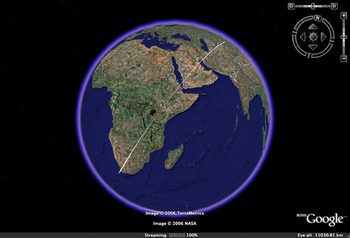
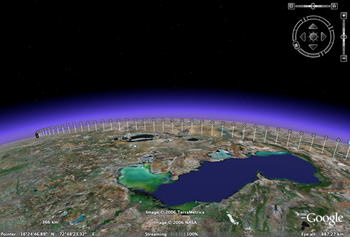
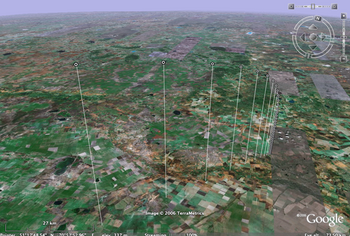
Ministry of transport
Posted on Tuesday, November 14, 2006

Its not related to the theme of this blog, or maybe in the way it looks very second life while being actually first life, a ministry in our 'outer space'...The merger of outer space and the digital space might be a copernican revolution in the making. A flip in perspective, instead of a merger (what would that do to the relation between outer space and our daily lifes here on Earth?) (via we-make-money-not-art).
Another way things might go instead of merge, is the subject of this blog: The end of cyberspace (with the excellent slogan 'Goodbye virtual world. Hello new world')
The future is process, not a destination
Bruce Sterling
Everything is ultimately becoming information technology
Ray Kurzweil
Data is the Intel inside
Tim O'Reilly
There is only one machine and the web is its OS
Kevin Kelly
The medium is the message
Marshall McLuhan
